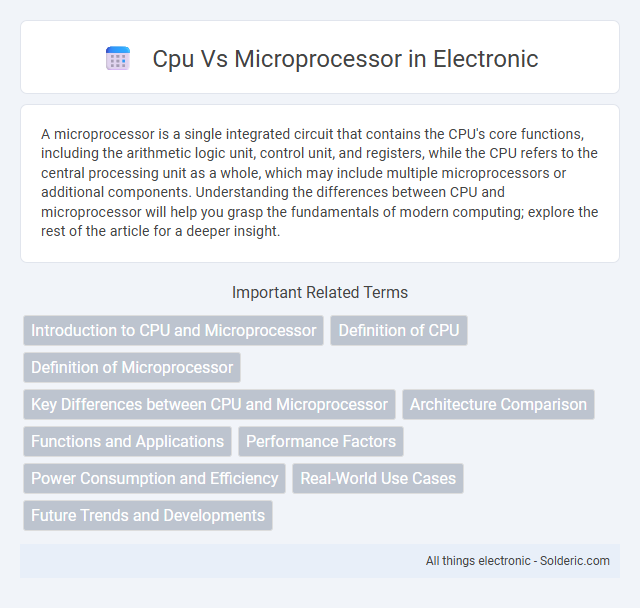A microprocessor is a single integrated circuit that contains the CPU's core functions, including the arithmetic logic unit, control unit, and registers, while the CPU refers to the central processing unit as a whole, which may include multiple microprocessors or additional components. Understanding the differences between CPU and microprocessor will help you grasp the fundamentals of modern computing; explore the rest of the article for a deeper insight.
Comparison Table
| Aspect | CPU (Central Processing Unit) | Microprocessor |
|---|---|---|
| Definition | Primary component that performs computations and controls tasks in a computer. | Integrated circuit that contains the CPU on a single chip. |
| Composition | May consist of multiple components like ALU, control unit, registers, often separate chips. | Single-chip processor integrating ALU, control unit, registers. |
| Function | Executes instructions and processes data in computers. | Processes instructions; used in embedded systems and computers. |
| Scope | Focuses on processing capabilities only. | Includes CPU plus additional components, e.g. cache, I/O interfaces. |
| Usage | Core processing unit in desktops, servers, laptops. | Widely used in embedded devices, microcontrollers, and PCs. |
Introduction to CPU and Microprocessor
A CPU (Central Processing Unit) is the core component responsible for executing instructions and processing data within a computer system, often integrated as a single chip in modern devices. A microprocessor is a specific type of CPU implemented on an integrated circuit, combining the processor's control unit, arithmetic logic unit (ALU), and registers into one compact chip. Microprocessors drive computing devices ranging from personal computers to embedded systems by performing arithmetic, logic, control, and input/output operations.
Definition of CPU
A CPU, or Central Processing Unit, is the primary component of a computer responsible for executing instructions and processing data. It performs essential tasks such as arithmetic, logic, control, and input/output operations that enable your device to function efficiently. While a microprocessor includes the CPU's core functions, the term "CPU" specifically refers to the processor unit within a system that carries out these key operations.
Definition of Microprocessor
A microprocessor is an integrated circuit that contains the functions of a central processing unit (CPU) of a computer on a single chip, enabling it to execute program instructions and perform arithmetic, logic, control, and input/output operations. Unlike a traditional CPU that may be part of a larger computer system with multiple components, a microprocessor acts as the brain of embedded systems and personal computers, providing compact and efficient processing power. Your understanding of computing components benefits from recognizing that a microprocessor consolidates processing capabilities into a small, cost-effective chip essential for modern electronics.
Key Differences between CPU and Microprocessor
The key differences between a CPU and a microprocessor lie in their scope and integration; a CPU (Central Processing Unit) is the core component responsible for executing instructions within a computer, while a microprocessor integrates the CPU along with other essential functions like memory and input/output control on a single chip. CPUs are often part of a larger system with separate chips managing other tasks, whereas microprocessors combine multiple functions into one compact unit, enhancing efficiency and reducing hardware size. Understanding these distinctions helps you choose the right technology for applications ranging from personal computing to embedded systems.
Architecture Comparison
The architecture of a CPU (Central Processing Unit) centers on executing instructions and managing basic computational tasks, typically featuring components like the arithmetic logic unit (ALU), control unit, and registers. In contrast, a microprocessor integrates the CPU along with additional elements such as memory controllers and input/output interfaces on a single chip, enabling more complex processing capabilities. Understanding these architectural differences can help you select the right component based on your system's performance and integration needs.
Functions and Applications
A CPU (Central Processing Unit) serves as the primary component responsible for executing instructions and processing data within a computer system, enabling tasks like calculations, decision-making, and task management. A microprocessor integrates the CPU functions onto a single chip, allowing it to control embedded systems, consumer electronics, and complex devices with higher efficiency and reduced size. Your choice between a CPU and a microprocessor depends on the intended application, where microprocessors excel in versatile, compact environments while standalone CPUs power personal computers and workstations.
Performance Factors
Performance factors of a CPU and a microprocessor depend on clock speed, number of cores, and architecture efficiency. Modern CPUs often feature multiple cores and advanced instruction sets, enhancing multitasking and processing speed compared to basic microprocessors used in embedded systems. Understanding these performance distinctions helps you choose the right processing unit for your computing needs.
Power Consumption and Efficiency
Microprocessors generally offer higher power efficiency compared to traditional CPUs due to their integration of multiple functions on a single chip, which reduces energy loss and heat generation. Advances in microprocessor design, such as smaller transistor sizes and optimized architectures, contribute to lower power consumption while maintaining high performance. CPUs often consume more power as they may comprise multiple separate components, leading to increased energy usage and less efficient thermal management.
Real-World Use Cases
CPUs power personal computers and laptops, enabling multitasking and running complex applications like video editing software and games, while microprocessors serve as the core of embedded systems in devices such as smartphones, smart appliances, and automotive control systems. In server environments, high-performance CPUs handle massive data processing and virtualization workloads crucial for cloud computing. Understanding the distinction helps you choose the right processing unit for applications ranging from everyday computing to specialized industrial use.
Future Trends and Developments
The future trends in CPU and microprocessor technology emphasize enhanced integration of AI-driven processing units and heterogeneous architectures to boost performance and energy efficiency. Advancements in semiconductor materials, such as graphene and silicon carbide, are poised to overcome current limitations in speed and thermal management, leading to smaller, more powerful microprocessors. Emerging developments in quantum computing and neuromorphic chips will likely redefine processing paradigms, pushing both CPUs and microprocessors toward unprecedented computational capabilities.
cpu vs microprocessor Infographic

 solderic.com
solderic.com